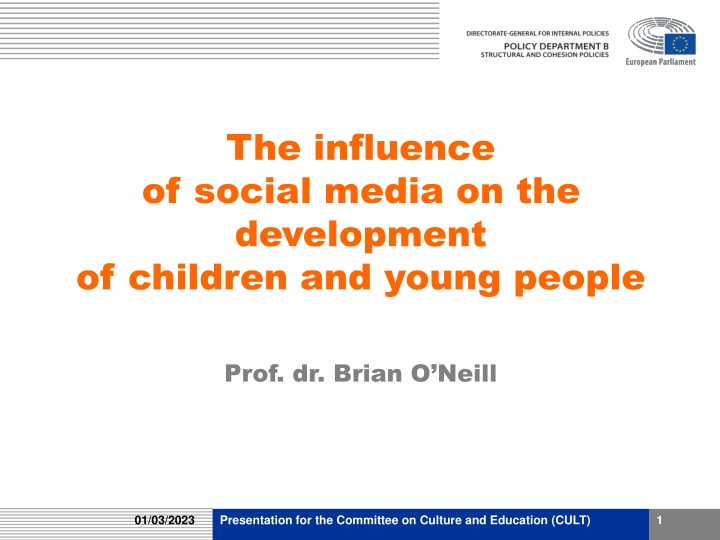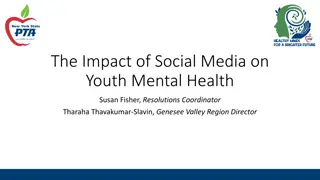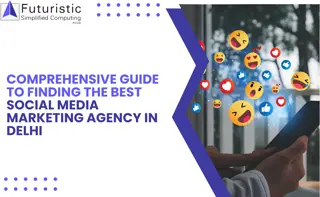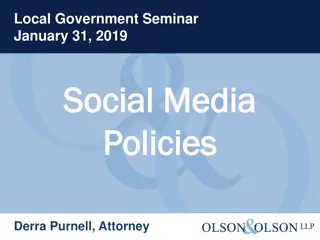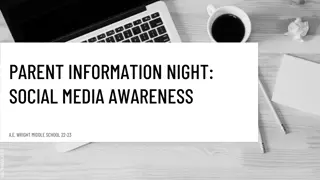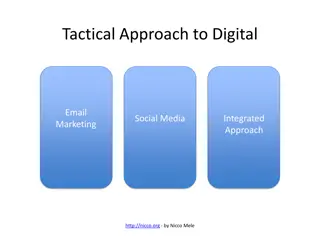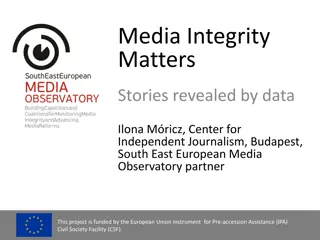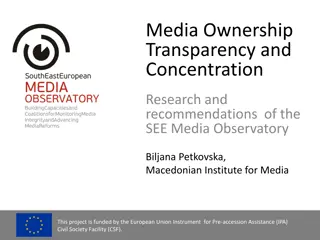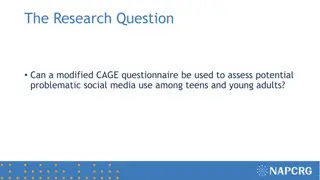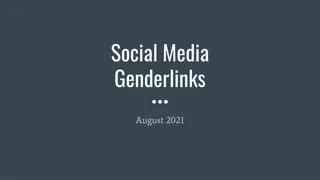The Influence of Social Media on Children's Development
This presentation by Prof. Dr. Brian O'Neill explores the impact of social media on the development of children and young people. It covers the prevalence of social media use, typical adolescent developmental tasks affected by social media, online risks such as harmful content and harmful adult contact, and EU policies and responses. The presentation also discusses the importance of media literacy and ethical values in navigating social media.
Download Presentation

Please find below an Image/Link to download the presentation.
The content on the website is provided AS IS for your information and personal use only. It may not be sold, licensed, or shared on other websites without obtaining consent from the author.If you encounter any issues during the download, it is possible that the publisher has removed the file from their server.
You are allowed to download the files provided on this website for personal or commercial use, subject to the condition that they are used lawfully. All files are the property of their respective owners.
The content on the website is provided AS IS for your information and personal use only. It may not be sold, licensed, or shared on other websites without obtaining consent from the author.
E N D
Presentation Transcript
The influence of social media on the development of children and young people Prof. dr. Brian O Neill 01/03/2023 Presentation for the Committee on Culture and Education (CULT) 1
Structure of the Presentation Structure of the Presentation 1. Context: Social media in the lives of children and young people 2. Main findings 3. EU policies, responses and solutions 4. Conclusions and recommendations 01/03/2023 Presentation for the Committee on Culture and Education (CULT) 2
Social media and childrens Social media and children s development development Typical adolescent developmental tasks: Social media defined as: Platforms and services that allow individuals and groups to create user profiles and connect their profiles with other users for the purposes of sharing user-generated content. Obar and Wildman (2015) Developing an independent sense of identity Forming new social relationships Self-disclosure Sexuality development Body image, gender identity and impression management Acquiring ethical values 01/03/2023 Presentation for the Committee on Culture and Education (CULT) 3
Social media use is pervasive Social media use is pervasive 80% of children aged 9 to 16 go online daily using a smartphone EU Kids Online (2020) Daily online use between 2 to 3.5 hours 77% use social media daily / 28% of 9-11 year olds use social media daily WhatsApp (96%), YouTube (95%) and Instagram (81%) most popular among 11-17 year olds Austria: Youth Internet Monitor (2022) 77% use TikTok daily Denmark: Internet use and social media (2021) 99% of 12-18 year olds have at least one social media profile 46% of this age group have between 2 and 5 profiles Top 5 platforms used by children (6-12) are: YouTube (86%), Netflix (68%), TikTok (56%), Spotify (52%) and WhatsApp (45%) Flanders: Apestaartjaren (2022) Top platforms for youth (12-18): YouTube (96%), WhatsApp (91%), Snapchat (91%), TikTok (86%) and Instagram (83%) 01/03/2023 Presentation for the Committee on Culture and Education (CULT) 4
CO:RE classification of online risks CO:RE classification of online risks Source: CO:RE Children Online: Research and Evidence (Livingstone & Stoilova, 2021) 01/03/2023 Presentation for the Committee on Culture and Education (CULT) 5
Main findings Main findings Content risks: Hateful and aggressive content Problematic eating habits / eating disorders of particular developmental relevance Disinformation and gaps in media literacy Harmful adult contact: Stranger contacts: children do not always recognise cues or danger signals Risks of ideological ideological manipulation / radicalisation Media literacy is key 01/03/2023 Presentation for the Committee on Culture and Education (CULT) 6
Main findings Main findings Peer conduct risks: Persistent and commonplace experience of cyberbullying Problematic social media use Sexual harassment and unwanted sexualised communication Contract risks: Hidden and unfair marketing practices Data profiling and algorithm based recommender systems Lack of transparency in social media influencer marketing 01/03/2023 Presentation for the Committee on Culture and Education (CULT) 7
Main findings Main findings Children s mental health a cross-cutting theme Important to consider offline as well as online factors and to consider both harm and benefits as far as mental health is concerned. there is evidence of associations between digital media and mental health problems. However, effects vary between individuals, with some being at much higher risk than others (Nutley & Thorell, 2022). Problematic social media use and poor mental health interrelated so that one problem promotes the other. 01/03/2023 Presentation for the Committee on Culture and Education (CULT) 8
EU policies, responses and solutions EU policies, responses and solutions BIK+ strategy (2022): Supporting children to be safe, protected and empowered when they go online A rights-based approach Enhanced / higher bar of protection for minors: Digital Services Act Audiovisual Media Services Directive General Data Protection Regulation Unfair Commercial Practices Directive 01/03/2023 Presentation for the Committee on Culture and Education (CULT) 9
Conclusions Conclusions Key findings: Social media use among children and young people is ubiquitous and has benefits as well as risks Affordances of social media highly appealing to young people given the important transitional developmental stages they experience Social media activities linked to many typical developmental tasks However, it is essential that young people are not exploited as a consequence of their developmental state, their evolving capacities, and vulnerability 01/03/2023 Presentation for the Committee on Culture and Education (CULT) 10
Recommendations Recommendations 1.Safety by design is an important concept that should be endorsed and promoted within regulatory discourse. 2. Age-appropriate design has the potential to mainstream the safe, empowered and rights- respecting participation of young people and should be similarly promoted within the policy sphere. 3. Continued development of privacy protections for children s data in the social media environment is essential. 4. Age assurance and digital identity systems require multistakeholder support if barriers to their implementation are to be overcome and to be effective. 5. To future-proof policies and to ensure that existing policies and initiatives are appropriate and effective, there is a need for a strong research observatory function at the European level. 01/03/2023 Presentation for the Committee on Culture and Education (CULT) 11
Thank you for your attention Thank you for your attention Q&A 01/03/2023 Presentation for the Committee on Culture and Education (CULT) 12
